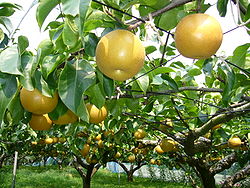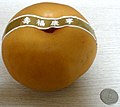Pyrus pyrifolia
Species of pear with round crisp grainy fruit From Wikipedia, the free encyclopedia
Pyrus pyrifolia is a species of pear tree native to southern China and northern Indochina that has been introduced to Korea, Japan and other parts of the world.[1] The tree's edible fruit is known by many names, including Asian pear,[2] Persian pear, Japanese pear,[2] Chinese pear,[2][3] Korean pear,[4][5][6] Taiwanese pear, apple pear,[7] zodiac pear, three-halves pear, papple, naspati and sand pear.[2] Along with cultivars of P. × bretschneideri and Pyrus ussuriensis, the fruit is also called the nashi pear.[8][9] Cultivars derived from Pyrus pyrifolia are grown throughout East Asia, and in other countries such Pakistan, Nepal, Australia, New Zealand, and America. Traditionally in East Asia the tree's flowers are a popular symbol of early spring, and it is a common sight in gardens and the countryside.
 Nashi pear (Pyrus pyrifolia) | |||||||||||||||||||||||||||||||||||||||||||||
| Nutritional value per 100 g (3.5 oz) | |||||||||||||||||||||||||||||||||||||||||||||
|---|---|---|---|---|---|---|---|---|---|---|---|---|---|---|---|---|---|---|---|---|---|---|---|---|---|---|---|---|---|---|---|---|---|---|---|---|---|---|---|---|---|---|---|---|---|
| Energy | 176 kJ (42 kcal) | ||||||||||||||||||||||||||||||||||||||||||||
10.65 g | |||||||||||||||||||||||||||||||||||||||||||||
| Sugars | 7.05 g | ||||||||||||||||||||||||||||||||||||||||||||
| Dietary fiber | 3.6 g | ||||||||||||||||||||||||||||||||||||||||||||
0.23 g | |||||||||||||||||||||||||||||||||||||||||||||
0.5 g | |||||||||||||||||||||||||||||||||||||||||||||
| |||||||||||||||||||||||||||||||||||||||||||||
| †Percentages estimated using US recommendations for adults,[10] except for potassium, which is estimated based on expert recommendation from the National Academies.[11] | |||||||||||||||||||||||||||||||||||||||||||||
| Pyrus pyrifolia | |
|---|---|
 | |
| Scientific classification | |
| Kingdom: | Plantae |
| Clade: | Tracheophytes |
| Clade: | Angiosperms |
| Clade: | Eudicots |
| Clade: | Rosids |
| Order: | Rosales |
| Family: | Rosaceae |
| Genus: | Pyrus |
| Section: | Pyrus sect. Pashia |
| Species: | P. pyrifolia |
| Binomial name | |
| Pyrus pyrifolia | |
| Synonyms[1] | |
|
List
| |
The fruits are not generally baked in pies or made into jams because they have a high water content and a crisp, grainy texture, very different from the European varieties. They are commonly served raw and peeled.[12] The fruit tends to be quite large and fragrant. When carefully wrapped, having a tendency to bruise because of its juiciness, it can last for several weeks (or more) in a cold, dry place.
Culture
Summarize
Perspective
Due to their relatively high price and the large size of the fruit of cultivars, the pears tend to be served to guests, given as gifts, or eaten together in a family setting.[13][14]
In cooking, ground pears are used in vinegar- or soy sauce-based sauces as a sweetener, instead of sugar.[15] They are also used when marinating meat, especially beef, with a notable example being in the Korean dish bulgogi, due to the presence of enzymes to tenderize the proteins in the meat.[16][17]
In Australia, these pears were first introduced into commercial production beginning in 1980.[18]
In Japan, fruit is harvested in Chiba, Ibaraki, Tottori, Fukushima, Tochigi, Nagano, Niigata, Saitama and other prefectures, except Okinawa. Nashi (梨) may be used as a late Autumn kigo, or "season word", when writing haiku. Nashi no hana (梨の花, pear flower) is also used as a kigo of spring.[19] At least one city (Kamagaya-Shi, Chiba Prefecture) has the flowers of this tree as an official city flower.[15]
In Nepal (Nepali: Naspati नस्पाती) and the Himalayan states of India, they are cultivated as a cash crop in the Middle Hills between about 1,500 and 2,500 metres (5,000 and 8,000 ft) in elevation, where the climate is suitable. The fruit are carried to nearby markets by human porters or, increasingly, by truck, but not for long distances because they bruise easily.[20]
In Taiwan, pears harvested in Japan have become luxurious presents since 1997 and their consumption has jumped.[13][14]
In China, the term "sharing a pear" (Chinese: 分梨; pinyin: fēn lí) is a homophone of "separate" (simplified Chinese: 分离; traditional Chinese: 分離; pinyin: fēnlí). As a result, sharing a pear with a loved one can be read as a desire to separate from them.[21]
In Korea, the fruit is known as bae (배),[15] and it is grown and consumed in great quantity. In the South Korean city of Naju, there is a museum called The Naju Pear Museum and Pear Orchard for Tourists (나주 배 박물관 및 배밭 관광체험).[22]
In Cyprus, the pears were introduced in 2010 after initially being investigated as a new fruit crop for the island in the early 1990s. They are currently grown in Kyperounta.[23]
Cultivars
Summarize
Perspective
Cultivars are classified in two groups. Most of the cultivars belong to the Akanashi ('Russet pears') group, and have yellowish-brown rinds. The Aonashi ('Green pears') have yellow-green rinds.


Important cultivars include:
- 'Chojuro' (長十郎, Japan, 1893?)[24][25] ('Russet pears')
- 'Kosui' (幸水, Japan, 1959; the most important cultivar in Japan)[26][27] ('Russet pears')
- 'Hosui' (豊水, Japan, 1972)[28][29] ('Russet pears')
- 'Imamuraaki' (今村秋, Japan, native)[30] ('Russet pears')
- 'Nijisseiki' (二十世紀, Japan, 1898; name means "20th century", also spelled 'Nijusseiki')[31][32] ('Green pears')
- 'Niitaka' (新高, Japan, 1927)[33][34] ('Russet pears')
- 'Okusankichi' (晩三吉, Japan, native)[35][36] ('Russet pears')
- 'Raja' (new)[37] ('Russet pears')
- 'Shinko' (新興, Japan, pre-1941)[38][39] ('Russet pears') ('Russet pears')
- 'Hwangkeum' (황금, 黄金, Korea, 1984, 'Niitaka' × 'Nijisseiki')
- 'Huanghuali' (not to be confused with the wood of Dalbergia odorifera, also called Huanghuali)[40][41]
Pyrus pyrifolia var. culta
You can help expand this article with text translated from the corresponding article in Japanese. (December 2024) Click [show] for important translation instructions.
|
| Pyrus pyrifolia | |
|---|---|
 | |
| Scientific classification | |
| Kingdom: | Plantae |
| Clade: | Tracheophytes |
| Clade: | Angiosperms |
| Clade: | Eudicots |
| Clade: | Rosids |
| Order: | Rosales |
| Family: | Rosaceae |
| Genus: | Pyrus |
| Species: | |
| Variety: | P. p. var. culta |
| Trinomial name | |
| Pyrus pyrifolia var. culta (Makino) Nakai | |
Pyrus pyrifolia var. culta (梨) is a Japanese cultivar of pears.[42][43][44][45] It is also known as a Nashi tree.[46][47][48] Sometimes called the Sand Pear[49][50]
Yamanashi Prefecture is named after the fruit.
Kanji
It has a Chinese character representing it in Japanese (梨). It is one of the Kyōiku kanji or Kanji taught in elementary school in Japan.[51]
It is one of the 20 kanji added to the Kyoiku kanji that are found in the names of the following prefectures of Japan[52]
It also generically refers to Pears in Chinese.
Gallery
- A Japanese pear wrapped with a ribbon to give as a gift. A United States quarter is provided for scale
- Sliced
- Whole and cut
- Padded to stop bruising
- Compared to a hand
- Group foamed for shipping
- At a South Korean market
- Nashi pear tree in bloom
- Whole Golden Asian Pear
- Whole Golden Asian Pear
Notes
External links
Wikiwand - on
Seamless Wikipedia browsing. On steroids.










